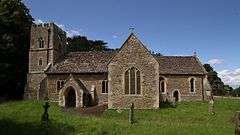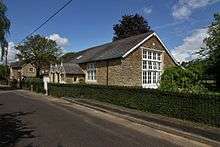Hinton Waldrist
| Hinton Waldrist | |
 |
|
 Hinton Waldrist |
|
| Population | 328 (2011 Census) |
|---|---|
| OS grid reference | SU3799 |
| Civil parish | Hinton Waldrist |
| District | Vale of White Horse |
| Shire county | Oxfordshire |
| Region | South East |
| Country | England |
| Sovereign state | United Kingdom |
| Post town | Faringdon |
| Postcode district | SN7 |
| Dialling code | 01865 |
| Police | Thames Valley |
| Fire | Oxfordshire |
| Ambulance | South Central |
| EU Parliament | South East England |
| UK Parliament | Wantage |
| Website | Hinton Waldrist on the Web |
|
|
Coordinates: 51°41′20″N 1°27′29″W / 51.689°N 1.458°W
Hinton Waldrist is a village and civil parish in the Vale of White Horse, England. It was part of Berkshire until the 1974 boundary changes transferred it to Oxfordshire. The village is between Oxford and Faringdon, 9 miles (14 km) southwest of Oxford. The parish includes the hamlet of Duxford. The 2011 Census recorded the parish's population as 328.[1]
Manor
In 1086 the Domesday Book recorded the village as Hentone, Old English for "high farmstead".[2] In the 12th century the manor passed to the St. Valery family, from whom the village took the second part of its name. In 1332 the manor was acquired by William de Bohun, 1st Earl of Northampton, whose granddaughter Mary de Bohun became the first wife of Henry IV. The manor was subsequently held by John Ramsay, 1st Earl of Holderness, Sir Henry Marten and the Loder family.[3]
The oldest part of Hinton Manor House is a late 16th-century Elizabethan building. About 1700 John Loder had it refronted and a new block added to the rear. Additions to the house, including an orangery and a Gothic revival-style wing, were built about 1830. An extra storey was added to one wing about 1860. The house is a Grade II* listed building.[4]
Castle
The earthworks of a former motte-and-bailey castle are southwest of the moated manor house.
Parish church
The Church of England parish church of St Margaret is mid-13th-century. It is cruciform, completed in the late 13th century by the addition of the south transept.[5] Several of the windows and their stained glass are 19th-century. Inside the church are several monuments to members of the Loder family and one to the Conservative politician Airey Neave lived in the village and was assassinated by the Irish National Liberation Army in 1979. The church is a Grade II* listed building.[6]
The west tower is Decorated Gothic[5] and has a ring of six bells. Abraham I Rudhall of Gloucester cast the second, third and fourth bells in 1709. William Taylor of Loughborough cast the fifth bell in 1843, presumably at the foundry he had at that time in Oxford. Mears and Stainbank of the Whitechapel Bell Foundry cast the tenor bell in 1868. John Taylor & Co of Loughborough cast the treble bell in 1928.[7]
St Margaret's parish is part of the Benefice of Cherbury with Gainfield.[8]
The oldest part of the Old Rectory is the rear wing, which is 14th-century. It has three crucks and was built as a hall house. The central part of the house was added in the 17th century, and the front was added about 1840. It is a Grade II* listed building.[9] It is no longer a clergy residence.

School
The parish school was built in 1850. By 1924 it was an elementary school.[3] It has since been closed and the building converted into a private house.
Scenes in our Village
Hinton Waldrist is the subject of 59 stereoscopic images produced by the Victorian photographer T.R. Williams in 1856.[10] The series of photographs is the subject of a book entitled A Village Lost and Found, co-authored by Queen guitarist Brian May.[11]
References
- ↑ "Area: Hinton Waldrist (Parish): Key Figures for 2011 Census: Key Statistics". Neighbourhood Statistics. Office for National Statistics. Retrieved 18 April 2016.
- ↑ Mills & Room 2003, p. s.v. Hinton.
- 1 2 Page & Ditchfield 1924, pp. 463–466.
- ↑ Historic England. "Hinton Manor (Grade II*) (1182212)". National Heritage List for England. Retrieved 18 April 2016.
- 1 2 Pevsner 1966, p. 155.
- ↑ Historic England. "Church of St Margaret (Grade II*) (1048641)". National Heritage List for England. Retrieved 17 December 2011.
- ↑ Davies, Peter (3 February 2014). "Hinton Waldrist S Margaret". Dove's Guide for Church Bell Ringers. Central Council for Church Bell Ringers. Retrieved 18 April 2016.
- ↑ Archbishops' Council. "Benefice of Cherbury with Gainfield". Church of England. Retrieved 18 April 2016.
- ↑ Historic England. "The Old Rectory and Old Rectory Cottage (Grade II*) (1368397)". National Heritage List for England. Retrieved 18 April 2016.
- ↑ May & Vidal 2009.
- ↑ Roe, Nicholas (15 October 2009). "Brian May rediscovers 'lost' village". The Daily Telegraph. Retrieved 1 November 2009.
Sources
- May, Brian; Vidal, E (2009). A Village Lost and Found: Scenes in Our Village by T. R. Williams. An Annotated Tour of the Celebrated 1850s Stereo Card Series. Frances Lincoln.
- Mills, A.D.; Room, Adrian (2003). A Dictionary of British Place-Names. Oxford: Oxford University Press. ISBN 0-19-852758-6.
- Page, W.H.; Ditchfield, P.H., eds. (1924). A History of the County of Berkshire. Victoria County History. 4. assisted by John Hautenville Cope. London: The St Katherine Press. pp. 463–466.
- Pevsner, Nikolaus (1966). Berkshire. The Buildings of England. Harmondsworth: Penguin Books. p. 155.
External links
| Wikimedia Commons has media related to Hinton Waldrist. |
